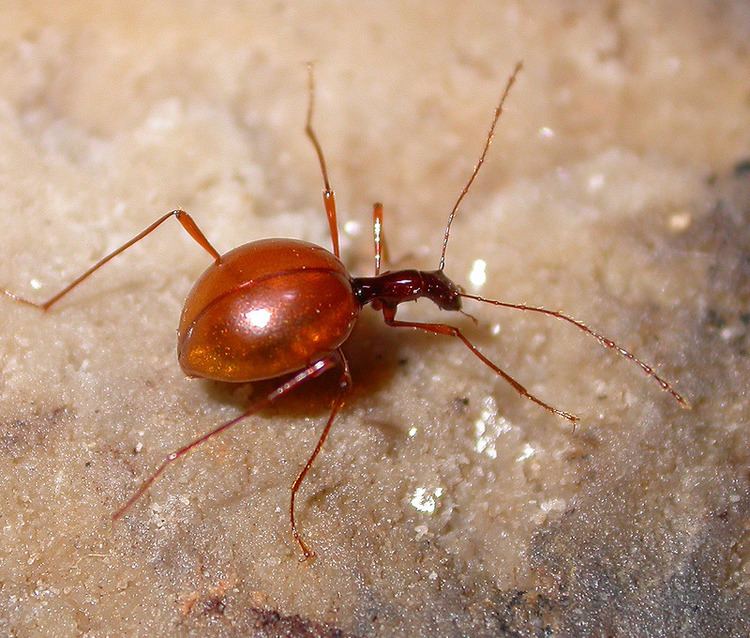Kingdom Animalia Order Coleoptera Family Leiodidae Scientific name Leptodirus hochenwartii Rank Species | Phylum Arthropoda Suborder Polyphaga Genus Leptodirus Higher classification Leptodirus | |
 | ||
Similar Leptodirus, Beetle, Insect, Leiodidae, Leptodirini | ||
Leptodirus hochenwartii, or L. hohenwarti, is a cave beetle in the family Leiodidae and the only species in the genus Leptodirus. It is a true troglobite, adapted to the life underground and unable to survive outside. Its distinguishing features are slender thorax, elongated legs and antennae, the absence of pigment in the integument, and completely reduced eyes. But perhaps the most striking feature are the domed elytrae which cover the abdomen completely and give it a round (so-called "physogastric") appearance.
Contents
It lives predominantly in large caves where the temperature does not exceed 12 °C. Its ecology is largely unknown, but the specimens were seen feeding on carcasses of different cave animals and other organic material. Even less is known about its life history; the only study done so far determined that it reproduces and grows slowly. Females lay a small number of relatively large eggs which take a long time to develop. The number of larval instars is reduced to only one, and the larvae do not feed before moulting.
Taxonomy and range
L. hochenwartii is endemic to western Dinaric Alps. Six subspecies are currently recognized:
Of those, three are found in Slovenia, and the others are found in Croatia. The southernmost known location is Velebit range in Croatia where subspecies L. h. velebiticus was described, and subspecies L. h. reticulatus was originally found in Grota Noe near Trieste (Italy). The exact status of several subspecies and forms is problematic to determine because specimens can differ significantly in physical characteristics even within the same population.
Research history
The animal was first found in 1831 by Luka Čeč, an assistant to the lamplighter, when exploring the newly discovered inner portions of the Postojna cave system in southwestern Slovenia. He gave it to Earl Franz von Hohenwart who was unable to determine the species, and gave the specimen in turn to Ferdinand J. Schmidt, a naturalist from Ljubljana. Schmidt recognized the beetle as a new species and described it in the paper Illyrisches Blatt (1832). He named it Leptodirus Hochenwartii after the donor, and also gave it Slovene name drobnovratnik and German Enghalskäfer, both meaning "slender-necked (beetle)". The article represents the first formal description of a cave animal (the olm, described in 1768, wasn't recognized as a cave animal at the time). Subsequent research by Schmidt revealed further previously unknown cave inhabitants, which aroused considerable interest among natural historians. For this reason, the discovery of L. hochenwartii (along with the olm) is considered as the starting point of biospeleology as a scientific discipline.
Conservation
Due to its limited range and slow reproduction, L. hochenwartii is considered rare and vulnerable, despite the fact that density in some caves can be high. As such, the species is included in the Slovenian Red list of threatened species (category R). Additionally, it is included in the Annex II of the EU Habitats Directive (92/43/EEC); on this basis, 15 areas of conservation (pSCI) are established in Slovenia which include the majority of known localities.
